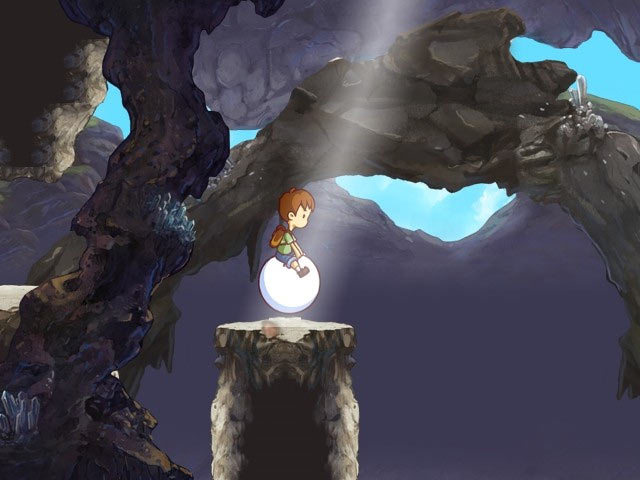
|
Some readers noticed we’ve talked a lot about Tetris and match-three games this week. That we have isn’t too surprising; when we were little kids Tetris was “the” puzzle game on nearly any Nintendo platform. Therefore, many of us tried it and most of us really liked it– just like millions of other people around the world.
But the puzzle genre wouldn’t be noteworthy if all it comprised were Tetris and match-three derivatives. Since the ’80s, clever designers and developers have come up with even more addictive ways to stump and challenge us, and this feature will cover the most interesting and exciting splinter genres that have arisen in the last couple console generations. Yes, we’ll always have a new Tetris-styled game to look forward to no matter what the machine, but may we suggest trying out some of these others on Wii and DS… You’re likely to get hooked all over again.
To jump to a specific subgenre, use the links below.
- Arcade Puzzlers
- Education & Logic
- Puzzle Platformers
- Physics
- Tower Defense
- Hybrid Puzzlers
- Other Subgenres
Arcade Puzzlers
Arcade Puzzlers prioritize strategic thinking at the same level of twitch reflexes. They’re usually too abstract to follow traditional platformer or falling shape rules, but they’re definitely still puzzlers. On Nintendo machines, we’ve seen a lot of gems in this subgenre, and it’s also well represented on other platforms in games like Every Extend Extra Extreme and Lazy Raiders. Yet I may be biased in believing the best are found on Nintendo hardware, as most of the addictive Art Style games on WiiWare and DSiWare fit this description. Often surreal but sometimes inspired by real life concepts, such as the orbit of planets or directing traffic, you can’t go wrong with nearly any Art Style game.
Recommended…
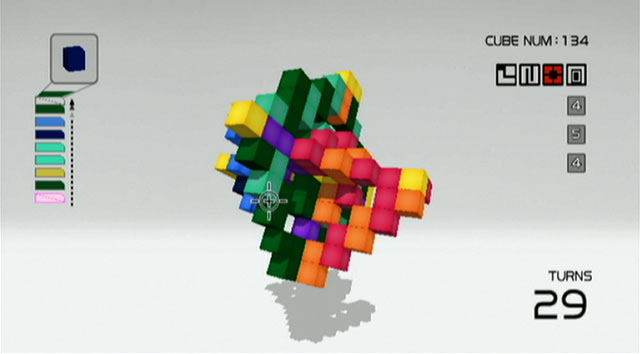
Art Style: Cubello / WiiWare
A cloud of cubes spins in space, and you must use the Wii remote pointer to fire like-colored cubes at the mass, attempting to clear off all but the middle core cube– the “cubello.” If your fired cube comes in contact with three adjacent, like-colored cubes, they clear off and the block of cubes reconfigures to a smaller size. With each shot the block of cubes spins in the direction of fire, all while slowly approaching the screen. Being patient enough for the blocks to spin to the right angle for a good shot, while also being quick enough to keep them from crashing into the screen, taps into both zen-master and ninja reflexes.


Art Style: Pictobits / DSiWare
You have an array of tiny, single-colored blocks at your disposal. Larger chunks of blocks appear on the touch screen, and you must place your tiny blocks so that when the larger ones fall on to your placed bits, complete square shapes are formed. If successful, all the blocks in a completed square shape are shot up on to the top screen where, pixel-by-pixel, a portrait of an 8-bit Nintendo character is created. The game’s all set to classic NES tunes that can even be played, jukebox style, while your DSi is closed.
Other Recommendations
- Art Style: Orbient (WiiWare) Your planet eats others to become bigger in size, but you only control gravitational pull and repulsion. The most chill of this subgenre.
- Art Style: Digidrive (DSiWare) You direct “cars” through an intersection to park in like-colored groups. Groups of five build up fuel you can use to push a spike away. Yes, it’s that odd.
- Art Style: Precipice (DSiWare) You run and climb over cubes to change their colors, keeping mind to not let a cube fall on top of your little guy.
- Punch-Out!! (Wii) Yes, it’s a boxing game, but figuring out the correct pattern to defeat your enemies is much more a puzzle than you’d think.
- Roogoo’s Twisted Towers (Wii & DS) You spin plates so that falling shapes fall through the right holes, and stack up at the bottom.
- ColorZ (WiiWare) You navigate up to three individual UFOs– single handedly– juggling their colors to slip them through a microbial mass of like-colored balls.
Education & Logic
One of the watershed games on DS has unequivocably been Brain Age, which kicked off a worldwide obsession with keeping your brain “in shape.” Of all the puzzle sub-genres, this can be one of the most relaxing and least abstract pursuits, unless a timer is involved. Solving math problems, using deductive logic and sometimes just identifying (not necessarily even matching) colors and shapes is all that’s needed here. When I was a kid, if someone had given me the option to figure out a logic puzzle or play a video game, I would’ve chosen video game, but in this genre, the best of both are combined. This type of puzzle game is the foundation of some other great games, which we’d mention here but will save for the “hybrid” section later.
Recommended…
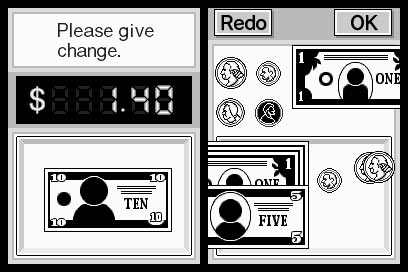
Brain Age 2: More Training in Minutes a Day / DS
You could get the original, but why not pick up the sequel which includes a beefed up Sudoku mode as well as the sublime Dr. Mario spin-off Virus Buster? Few games take advantage of everything DS is capable of like the Brain Age games, which will have you writing out answers, saying them, listening to questions and piano tones, and more. Grouped with the carnival-like assessment of your brain’s age (from 20 to 80 years old!), and the encouragement and cheeky ribbing of Dr. Ryuta Kawashima’s avatar– who even remembers if you don’t play the game for a long time– this is a rather unforgettable and entertaining experience.


Art Style: Boxlife / DSiWare
There’s not as much variety in this one, but it’s definitely in the same vein. You’re a worker n a humble box factory, given odd shapes of grid paper. You must use your stylus to specify where the paper must be cut in order to create six shapes that can fold up into cubes. With a charming retro visual and audio presentation, this is a winner, but also a bit steeper on the difficulty curve.
Other Recommendations
- Brain Challenge (Wii and DS) Gameloft’s take on the Brain Age formula is more colorful and complemented with its own suite of simple brain teasing games, and a comely scientist mentor.
- Big Brain Academy (DS) This is Nintendo’s version of Brain Age that’s more aimed towards children, but still fun and mentored by a sentient chunk of earwax!
- Neves Plus (DS and WiiWare) If you like the Asian tabletop game Tangram, you’ll love Neves, as it’s about creating shapes from smaller, differently sized geometric tiles.
Puzzle Platformers
Most platform games require rote skill and some memorization. These platformers require more cunning in skills, items, transformations and more to get through their challenges. Yet uniting them all is the navigation of a character through a world, often side-scrolling. Lode Runner is probably the original puzzle platformer, but Nintendo gamers have been given many new, attractive options in this action-styled twist on puzzlers.
Recommended…
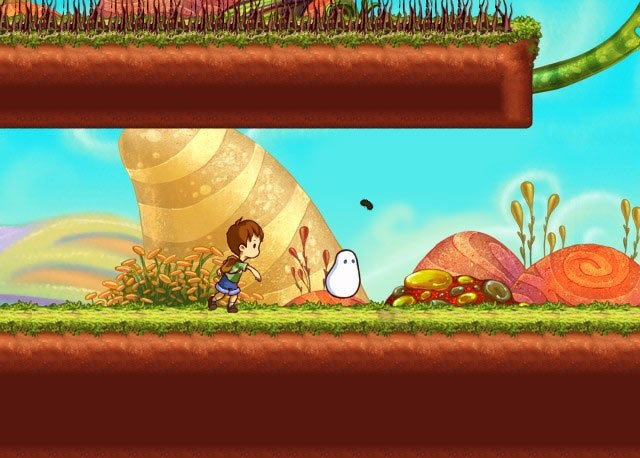
A Boy and His Blob / Wii & 3DS
WayForward Technologies’ lovingly crafted remake of an NES title takes the original concept of guiding a boy and his alien, jellybean-loving blob from Earth to outer space and makes a must-play experience. With brand new puzzles top to bottom (40 levels), as well 40 more unlockable challenge levels, gamers get more than their money’s worth and more than the original game had to offer. The game’s hero, a little boy, is generally only good for shouting blob’s name to call him over, giving him the occasional hug (incredibly cute) and of course throwing differently-flavored jellybeans to transform the white blob into ladders, holes, balloons and other items that will eliminate cute, shadowy monsters and provide safe travel over dangerous hazards. The concept and gameplay are solid enough, but the hand-drawn and -painted visuals, along with a serene soundtrack, make for icing on the cake. Bonus: a 3DS version is coming up.
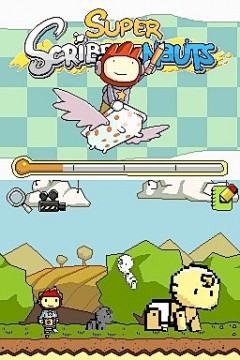

Super Scribblenauts / DS
You could get the original, but the sequel’s vastly expanded and improved, and out in a few months, so why not get it instead? Like A Boy and His Blob, 5th Cell’s puzzler has a charming aesthetic all its own, and the massive breadth of items that can be summoned and used in the game ensure you get to see plenty of it, marveling over the thousands of words you can use to create objects, animals, monsters and more. In the game, hero Maxwell must collect starites in various platform levels. The gamer can write any noun desired to summon that person, vehicle, building, tool, animal, monster, food– you get the point– to help Maxwell navigate around obstacles, appease other creatures or people in the level, and so on. The sequel one-ups its predecessor by adding in support for thousands of adjectives, plus D-pad control of Maxwell, which is truly essential considering how many accidental deaths Maxwell endured in the first game when the game improperly registered “grab this object” as “run off this cliff and die.” The sequel also has a hint system that will keep gamers much more creative when their imaginations run dry.
Other Recommendations
- Mighty Flip Champs (DSiWare) Another Wayforward must-buy, this challenging platformer has the gamer flipping mirror image levels between the top and bottom screens, only the platforms and obstacles the heroine navigates aren’t in the same places.
- N+ (DS) Gamers must jump, rebound and sprint a ninja hungry for gold through hostile levels filled with droids, missles, bullets and mines.
- Drawn to Life: The Next Chapter (Wii & DS) Why write the names of your tools of puzzle solving as in Scribblenauts, when you can draw them? The tactile engagement of stylus-to-screen may make the 5th Cell-developed DS version even more fun when drawing your hero, his weapons and the platforms he traverses.
- Exit DS (DS) Gamers play as the suave Mr. ESC, who navigates hazards such as fires and earthquakes to escape buildings and rescue panicked disaster victims of various ability.
Physics
There really aren’t many physics-based puzzlers anymore, and I Heart Geeks, a riff on The Incredible Machine, seems MIA. But if you truly crave deducing how weight, structural stability, gravity and cause and effect will accomplish a goal, there’s still a couple solid options for you.
Recommendations

World of Goo / WiiWare
Half– maybe three-fourths– the reason of mentioning the physics subgenre is for this game. World of Goo is easily one of the quirkiest, addictive and well-made games on WiiWare, so its good buzz is not coincidental. Gamers have to assemble tinker toy-like structures of goo balls that will allow a remaining set of unused goo balls to traverse the gamer-built structure and get sucked up into a bottle. What happens to the goo balls after that is unknown– but the game does say the googly-eyed, squealing black balls are “delicious.” Perhaps they’re used in a funky version of boba tea, but that’s irrelevant when taking into account the terrific graphics, soundtrack and, yes, physics at play here. With a bonus online mode that challenges gamers to construct the tallest, free-standing goo ball structure as compared to all other “goo ballers,” there’s plenty to love in this Burton-esque game.

Mercury Meltdown Revolution / Wii
Can you believe there are maze toys made for children with real mercury in them? Sure, they’re fun (I had one, myself), but think about it for a second. The much safer alternative is this game, which combines aspects of Marble Madness and Super Monkey Ball with the endless splitting and unifying properties of liquid mercury. The video game also offers further magic with mercury, allowing it to be shifted to a fast, slow and solid state to navigate complex mazes that end with single or multiple (hence the splitting) end goals. Throw in the twist of also being able to recolor the mercury, and there’s plenty of tricky challenge to be had as the gamer tilts the maze worlds to guide the mercury just-so.
Tower Defense
Tower defense titles are partially in the real-time strategy genre but ultimately require much in the way of traditional puzzle solving, depending on whether the gamer must create mazes of destructive towers for hapless enemies to wander through, or just place towers along existing pathways the enemies traipse down. Regardless the game, the questions are often the same: Which tower will be best against the flying enemies? Should a slowing tower be put at the start, a major intersection or near the end? Should you wait to save your in-game money to buy that super powered laser tower, upgrade your existing ones, or spam the landscape with cheap pea-shooters? You don’t know until you try.
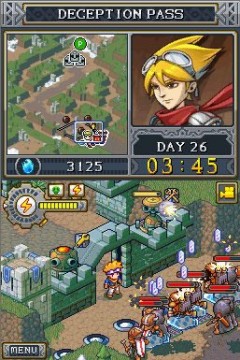
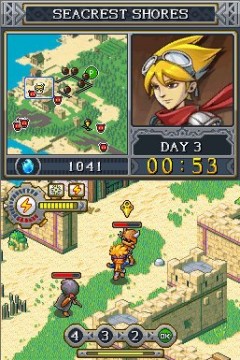
Lock’s Quest / DS
Much like WayForward Technologies, developer 5th Cell really can’t do any wrong, so far as Nintendo fanboys and a string of excellent titles are concerned. Lock’s Quest is one of 5th Cell’s best. As in most tower defense games, the hero has some time to construct offensive and defensive towers, bridged with walls, around crucial defense points. Then, a wave of enemies descends to attack the towers and defenses. What makes Lock’s Quest unique is its unusually rich story (for a tower defense game) and the ability to scramble around and repair towers and walls on the fly or go hand-to-hand with the evil robots with touch screen minigames. It’s a puzzle game not to be missed.
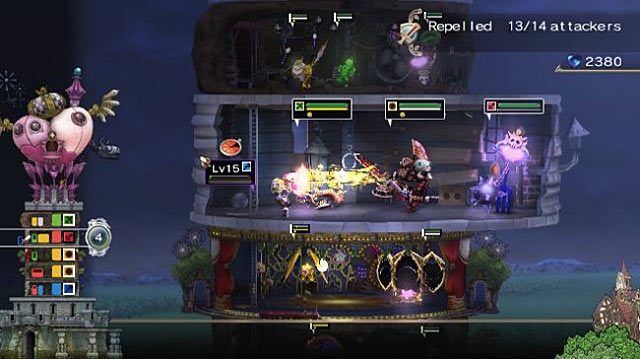 Final Fantasy Crystal Chronicles: My Life as a Darklord / WiiWare
Final Fantasy Crystal Chronicles: My Life as a Darklord / WiiWare
The first tower defense game within an actual tower, this WiiWare title takes a markedly different gameplay configuration– tower defense– as compared to its city-buidling sim predecessor, My Life as a King. Gamers play as Mira, petulant and rash daughter of the deceased Darklord. She’s concerned with protecting a powerful crystal at the top of her tower from waves of “heroic” adventurers and bandits seeking to destroy it, which she accomplishes by installing floor after extra floor in her tower, populating each floor with up to three traps, monsters or ability-harming devices. Once all the waves of adventurers are defeated, Mira literally flies her tower to a new location, often gaining new types of weapons and monsters along the way. While Darklord was vilified in the enthusiast press for having so much of its content (extra traps as well as levels) available only through microtranscations that would be spent on top of the game’s 1500 Nintendo point cost, there truly is plenty of content and challenge in the core game to make this a solid recommendation. Plus, it looks and sounds as great as its prequel.
Other Recommendations…
- Ninjatown (DS) This fixed-path tower defense title’s novelty is the towers are actually huts that attack ninjas pop out of to combat oncoming waves of devils. The cute factor’s on overload in this one.
- Robocalypse: Beaver Defense (WiiWare) This recent, downloadable-only sequel to Tecmo’s DS title Robocalypse diverges from its prequel’s pure RTS roots to provide a solid tower defense experience. Featuring a colorful, zany presentation in which gamers defend against a psychotic, mutated beaver and his hordes of robots, the game’s story is from former Spongebob Squarepants writers.
- Crystal Defenders R1 and R2 (WiiWare) This simplistic tower defense game was a cell phone game over in Japan and covers the utmost basics of a fixed-path tower defense design– decent but not a must-have unless you’re a very intimidated beginner.
Hybrid Puzzlers
Of all the many subgenres and mutations of puzzlers, the hybrids perhaps hold the most potential and some of our strongest recommendations. There’s not a simple, single definition for these titles other than they combine traditional puzzle game designs with some other genre that’s so strongly represented that it has equal presence on the game experience. Some folks would like to drop story-driven adventure games (like Broken Sword and Phoenix Wright) in this subgenre, but for the purpose of this piece we’re excluding those since progressing the story with logically interwoven elements of the game world, versus progressing through discrete puzzles, takes greater precedence in those experiences.

Puzzle Quest: Challenge of the Warlords (Hybrid of match-three puzzles and traditional RPGs) / DS and Wii
There’s no denying this is a match-three puzzle game, but then there’s no denying that this is a story-driven RPG, complete with spell casting, experience building and leveling up. What separates the Puzzle Quest games from Bejeweled and Jewel Quest is that you’re not just progressing from one screen of match-three to the next: you actually have a hero whose appearance, gender and name you’ve selected, and that hero moves along a world map, traveling from towns to forests and dungeons, battling small monsters and massive bosses, all via bouts of match-three. Matching certain colors will increase power for like-colored spells, as well as gather resources and inflict damage upon opponents. Incredibly captivating for RPG and puzzle fans, particularly those on the go, this title is worthy of the praise it has received.

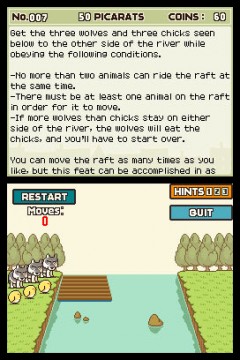
Professor Layton and the Curious Village (Hybrid of logic/brain teaser puzzles and story-driven adventure games) / DS
Level-5’s beautifully drawn and scored Professor Layton games show how to take the most mundane logic puzzles of our childhood (also seen heavily in Brain Age and other brain training games) and wrap them up in an intriguing story and world. That the characters are some of the best new heroes this side of Phoenix Wright makes the game even more appealing, though the Miyazaki-class design and top-notch voice acting don’t hurt. The fact that most of the game’s puzzles are often completely removed from any context or relevancy in solving the game’s mysteries puts this more in the “puzzle” than “adventure” camp, but as in Puzzle Quest, the story’s still quite compelling to work through. With extra minigames and free, weekly downloadable puzzles, there’s plenty to love and all the more reason to recommend its already-released and upcoming sequels, last year’s Diabolical Box and this September’s Unwound Future. The fourth game, a purported start of a second trilogy of prequels that tell Professor Layton and his apprentice Luke’s first adventures, will be released on 3DS under the name Professor Layton and the Mask of Miracle.
Other Recommendations…
- Henry Hatsworth and the Puzzling Adventure (DS, hybrid of side-scrolling platforming and match-three puzzles) This cheeky, beautiful game achieves the heretofore improbable combination of a challenging, beat-em-up platformer on the top screen with an always-present match-three game on the touch screen. Solid fun.
- Max and the Magic Marker (WiiWare, hybrid of side-scrolling platformer and physics puzzler) This lovely action-platformer requires the gamer to draw boulders, bridges and more on-screen with an orange magic marker. By manipulating the physics of these objects, hero Max can safely traverse and catapult through his adventure to defeat a villain from his own scribbles.
- Zack & Wiki (Wii, hybrid of 3D platforming and logic and physics puzzles) This underselling charmer has rakish pirate Zack ringing his flying monkey bell Wiki to transform enemies into handy tools. Figuring out which tools to use when will help Zack advance through 3D platforming challenges and fetch treasure chests.
Other Subgenres
There are other groupings and categorizations this special could cover, but I’ll leave the last two to simple recommendations.
Recommended Hidden Object Puzzlers
- Looksley’s Line-Up (DSiWare) The most novel use of the DSi’s buit-in camera that provides a 3D viewing experience. You look into an animated diorama that appears to have depth and dimension as you tilt your DSi, all thanks to the DSi’s camera tracking your face while you tilt the machine. Tilt the image just so, and items will line up to present the object (usually a number or letter) you’re trying to find.
- Huntsville: Case of the MillionHeir (DS) If it’s traditional hidden object puzzler you’re looking for, you can’t go wrong with this one, which comes from Big Fish Games, the metaphorical “big fish” in the casual puzzle games scene. Hunt for random objects in detailed paintings in an attempt to solve a murder mystery.
Recommended Navigation Puzzlers
- Rubik’s Puzzle Galaxy: Rush (WiiWare) If you never got enough of ChuChu Rocket! years ago, this cleanly designed game will satisfy your craving, if at least the single player-puzzle aspect of that craving. Drop arrow tiles on a landscape to direct rolling, colored blocks into like-colored exits.
- Art Style: Light Trax (WiiWare) This mesmerizing, disorienting and Lite Brite-colored racer is much more a puzzle than at first glance, when basic tenets of steering and acceleration are removed in favor of leeching speed from opponents and even sacrificing some of your life (at the right time) to get a boost.
Your Turn
What’s your favorite puzzle subgenre? What’s your favorite puzzle game or subgenre that’s not listed above? Let us know in the comments below.




 ShareThis
ShareThis







